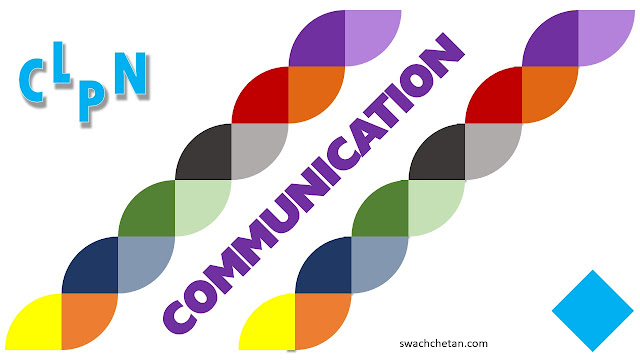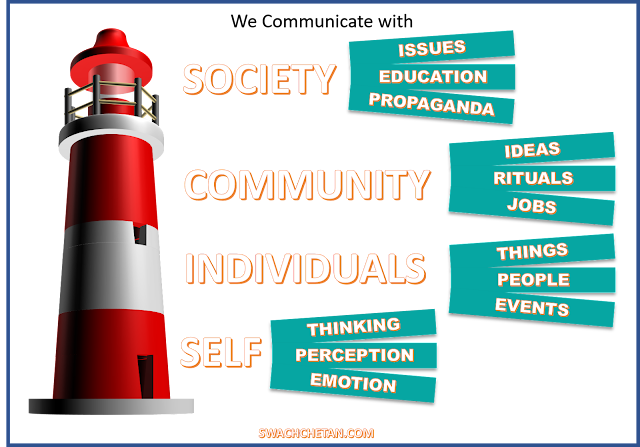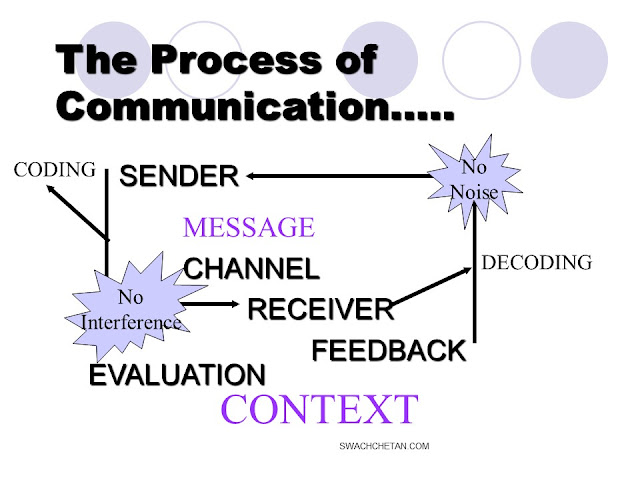COMMUNICATION SKILLS
What is Communication?
The word COMMUNE indicates
- To be together
- To work together
- To live together
Hence, the common factor and the keyword here is "Together"
The word COMMUNE indicates
- To be together
- To work together
- To live together
Hence, the common factor and the keyword here is "Together"
Two Purposes of Communication
PURPOSE 1: Converging the variety of ideas in diverse situations
If all of us were similar in thinking and perception, there would have been no need for communication
PURPOSE 2: Restoring the emotional friction of living together
If all of us could feel and act in similar ways, there would have been no need for communication
👉 👉 👉 👉 👉 👉
Sharing of thoughts, perceptions, feelings, and action is Communication
👆 👆 👆 👆 👆 👆
If all of us were similar in thinking and perception, there would have been no need for communication
PURPOSE 2: Restoring the emotional friction of living together
If all of us could feel and act in similar ways, there would have been no need for communication
👉 👉 👉 👉 👉 👉
Sharing of thoughts, perceptions, feelings, and action is Communication
👆 👆 👆 👆 👆 👆
Who do we Communicate with?
We communicate less with
- Our Family
- Our Parents
- Our Children
- Our Relatives
- Our Friends
- Our Neighbours
- Our Acquaintances
- Our Colleagues
- Our Classmates
- Our Well-wishers
- Others
We Communicate more with OURSELVES.
INNER COMMUNICATION
In such a case what do we communicate to ourselves? What is the content of our Inner Communication?
We can only communicate what we have more of - either beneficial to us or harmful to us
- A graduate attending a job interview
- A student preparing for the final exam
- An executive facing a board meeting
- A scientist propounding his findings
- A homemaker receiving relatives
- An athlete getting ready for a sports event
- An artist who is about to face competition
If what we have is positive, we can only communicate positive
To have more positive, we must take fewer negative
What exactly do we communicate to ourselves?
Let us say, we succeeded in over ten different jobs, we remember the one job where we failed. If a person's whole dance performance was fantastic, they only remember the one step that went wrong. Let over ten people praise us the whole day, we remember the one person who did not praise us. Or we etch into our mind the person who criticized us.
We are not interested in lots of people who come in search of us but we only want to meet the one person who often ignores us.
The Content of our Communication
What we say or do is not important but how we say or do is most important.
When we try to narrate yesterday's experience what comes out is our childhood experience. We can never say what we intend to say but we always say what we were hiding to say.
Many times, we assume that our thoughts get communicated and we need to remember that thoughts should be converted to words to get shared.
The role of Subconscious in Communication
Communication is not merely cyclical, but it works within a series of concentric circles. If our elders called us "names", we use the same names for the children. The way we were treated in our life, is the same way we treat others now but we are not well aware of it. The word "You Can't" is etched in our brains so strongly that we carry this communication even to our graves.
If you want to be the best communicator, then tell yourself that you are the best communicator. If you want to be the worst communicator, then tell yourself that you are the worst communicator. Both statements do not work here as you are afraid of being the best or worst communicator.
The subconscious has engraved in its recorder that you can neither be a best nor worst communicator. Any attempt to erase what is written in the recorder will only result in lots of pain and disorder. Cognitive dissonance will make sure not to disturb the order as being best or worst will push you in or out of the door.
Thus, irrespective of our conscious will, the subconscious takes charge of our communication.
Effective Inner Communication
If someone misunderstands you, it is not your faulty communication but it only means that you have no control over how someone can understand you.
When you are speaking for an audience, you may have been trained as a speaker but does the audience know that they are not yet trained as listeners?
Try to become the worst communicator and you will know how tough it is, in the same way, it is also not possible to become the best communicator.
Communication is not about the worst and the best communication but it is about how ineffective or effective we are in our communication.
OUTER COMMUNICATION
The Process of Communication
The following 11 Stages are involved in an ideal Communication
Stage 1:
It all starts with a sender who wants to communicate. However, s/he cannot do anything alone.
Stage 2:
S/he needs a receiver who can receive the information.
Stage 3:
Both the sender and the receiver need a context for making the communication. The context could be an office, any workplace, home, playground, party, an outing, or any other context.
Stage 4:
Once the context is there, a need for a channel is necessary. The channel could be oral (talking), written (Circulars, notices, posters, magazines, letters, emails, etc.), or interpersonal (gestures, facial expressions, body language, signs, symbols, etc.).
Stage 5:
The sender should have no interference while sending the message. Interference can cause serious lapses in communication.
Stage 6:
At the same time, the receiver should have no noise that can disturb communication. The receiver should be clear in his/her consciousness to receive information.
Stage 7:
The sender will have to code the information before sending it.
Stage 8:
There is a message the sender has to convey to the receiver.
Stage 9:
Once s/he sends the message, the receiver receives the message and then decodes the message. So, coding and decoding are the two major tasks that the sender and receiver will be doing. The sender should have no interference but should code the information properly. The receiver should filter out the noise and decode information correctly.
Stage 10:
Once the information is received, the receiver will have to give feedback to the sender.
Stage 11:
The sender should receive the feedback and then evaluate comparing the information that was conveyed. If the information has accurately reached the receiver and the feedback says so, the process of communication is over. In case the receiver has not received the message properly, the sender will have to resend the message. Probably there could be interference in the sender or the coding may not have been proper or the message has not been coded properly or sent properly. The receiver may not have decoded the message properly because of the noise, because of a lack of decoding mechanisms, not receiving the message properly, or not giving feedback properly.
In short, there has to be a sender and a receiver. There is a channel and there is a context. The message has to be coded by the sender without interference and the receiver has to decode the message without noise and then provide feedback to the sender always keeping in mind the context in which the process of communication is happening. This is then evaluated by the sender to verify that the intended message is received correctly.
The following are the stages we should remember to understand the communication process.
- Sender
- Receiver
- Context
- Channel
- No interference
- No noise
- Coding
- Message
- Decoding
- Feedback
- Evaluation
ACHIEVEMENTS through COMMUNICATION
What do we gain by communicating better? The following are the achievements through communication.
- Earn Respect
- Gain Acceptance
- Reduce Frustration
- Solve Problems
- Give Emotional Support
- Increase Self-confidence
- Overcome Guilt
- Satisfy Togetherness
- Ensure Well-being
When you keep these as your GOAL for communication, these sub-skills will complete your effective communication.
Action Plan for Developing Communication
Be aware of these experiences and whenever they happen, they should be tackled immediately. Otherwise, they will have a ‘snowball effect’ on the relationship.
|
Experience |
The date on which the experience
happened |
Potential Reasons |
Action Taken |
Evaluation of Action |
The date on which the problem was
rectified |
|
Loss of Respect |
|
|
|
|
|
|
Lack of Acceptance |
|
|
|
|
|
|
Feeling Frustrated |
|
|
|
|
|
|
Facing Problems |
|
|
|
|
|
|
Need for Emotional Support |
|
|
|
|
|
|
Lack of Self-esteem |
|
|
|
|
|
|
Feelings of Guilt |
|
|
|
|
|
|
Lack of Togetherness |
|
|
|
|
|
|
Lack of Well-being |
|
|
|
|
|
Barriers to Communication
- SELECTIVE ATTENTION
- SELECTIVE PERCEPTION
- SELECTIVE RETENTION
- Lack of clarity in thinking
- Difficulties in encoding
- Noise, Defensive
- Incomplete feedback
- Rumour
Benefits of Communication
- Creates interest and attention
- Develops good human relations
- Improves work performance
- Reduces frustration
Steps to Effective Communication
- Crystallize your ideas before communicating
- Invite Consent
- Express yourself completely
- Examine the purpose of communication and adopt suitable language and approach
- Consider others while planning communication
- Consult others while planning communication
- Be mindful of tone, voice, choice of language, the basic content of the message
- Make specific requests
- Be a good listener
- Actions should support communications
- Ask open-ended questions
- Communicate for tomorrow as well as for today
- Follow-up your communication, obtain feedback
- Convey something of help/value to the receiver
- Practice in all situations
















Please do not include any spam links in the comment box.